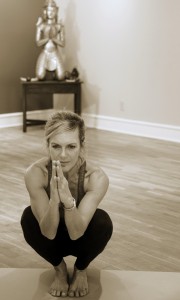Yoga might be the only time in your busy day that is truly yours; a time when all of your attention is directed to exactly what you are doing. Today over 15 million people in the US know the value of doing just that-relaxing with yoga. The yoga that we practice today rises out of an ancient meditation heritage dating back at least 4,000 years. Fast forward to today’s crazy hectic pace, especially with the approach of the holiday season, the benefits to your physical, mental and emotional health are top reasons why yoga still works.
1. Stress relief. Yoga reduces stress by encouraging relaxation and lowering the levels of the stress hormone cortisol. Yoga teaches you how to breathe more fully by taking slower, deeper breaths. Known as pranayama, breathing more fully helps improve lung function and trigger the body’s relaxation response. By changing our pattern of breathing, we can significantly affect our body’s experience and response to stress. Other benefits include reduced blood pressure, cholesterol and heart rate, improved immune system as well as reduced anxiety, depression, fatigue, insomnia, and easier pregnancies.
2. Pain relief. Next time you have a headache, neck, back, or other chronic painful conditions, yoga can help. In the largest US study to date, published in the Archives of Internal Medicine, yoga or stretching classes were linked to diminished symptoms from chronic low back pain, more so than a self-care book. Both the yoga and stretching class emphasized the torso and legs. Researchers found that the type of yoga, called viniyoga, which adapts and modifies poses for each student, along with breathing exercises, works because the stretching and strengthening of muscles benefit back function and symptoms. Many people with chronic pain shy away from yoga’s misleading reputation for requiring supple joints for fear of getting hurt. But the same goes for approaching any new activity with too much gusto, writes Kelly McGonigal, Ph.D., in Yoga For Pain Relief . Instead of pushing yourself to your limit, think of staying in a 50-60% effort zone.
3. Better Posture & Better Bones. Yoga helps to maintain your muscularity and that helps with maintaining your posture. It also helps with stretching all the muscle groups that support better body alignment. For women, increasing research is showing that exercise is a means of preventing the risk of various cancers, particularly breast cancer. The reasons are twofold, in that both the physical effects and indirect effect of adding yoga as a form of exercise prevents weight gain.
4. Befriending Your Body. For anyone who feels ashamed or self-conscious about their body, yoga can help you become an alley with yourself instead of an adversary. Our obsession with thinness equates the physical practice as a good way to sweat/ get /thin/quick; all about the outer body. Yet yoga primarily evolved for a subtle and more powerful connection of the inner world: the mind, senses and emotions. Today 90% of all women and junior and senior high school girls, respectively, dislike their bodies and are on a diet. ( 15% of these girls are actually overweight.) It doesn’t help that classes might be packed with thin fit people. While yoga does teach you to use and discipline your body to be strong and flexible, the emphasis is on your body as a whole entity: living, changing, accepting and alive in the moment.
This article was originally published in the Idaho Mountain Express. November 16, 2012.
Connie Aronson is an American College of Sports Medicine Health & Fitness Specialist. Visit her at: www.conniearonson.com

